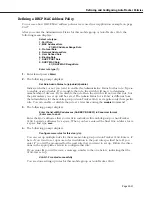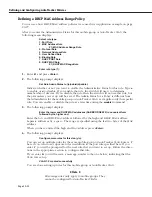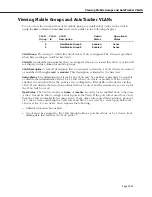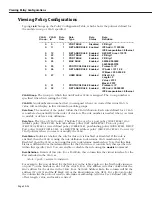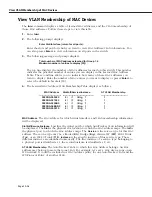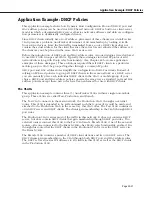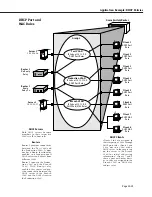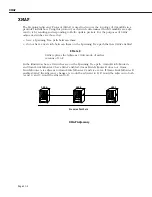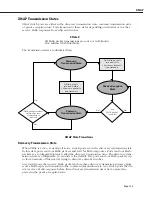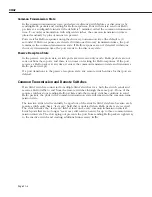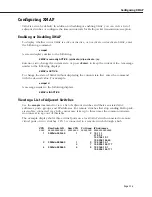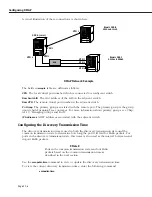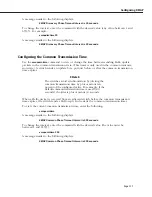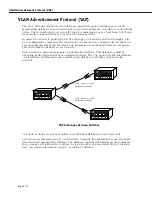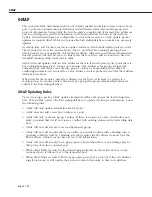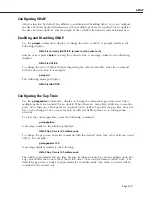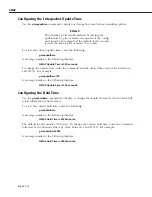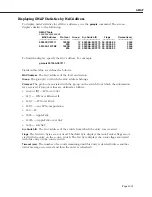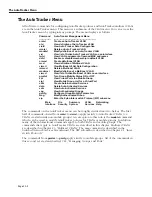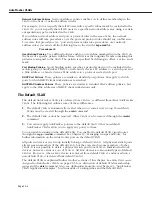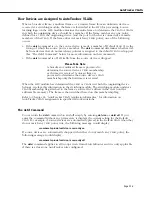
XMAP
Page 21-4
Common Transmission State
In the common transmission state, ports detect adjacent switch failures or disconnects by
sending Hello packets and waiting for Hello responses. Ports in this state send out Hello
packets at a configurable interval (the default is 5 minutes) called the
common transmission
time
. To avoid synchronization with adjacent switches, the common transmission time is
jittered randomly by plus or minus ten percent.
Ports wait for Hello responses using the
discovery transmission time
(the default is 30
seconds). If Hello responses are detected within one discovery transmission time, the port
remains in the common transmission state. If Hello responses are not detected within one
discovery transmission time, the port reverts to the discovery state.
Passive Reception State
In the passive reception state, switch ports are in receive-only mode. Hello packets are not
sent out from these ports, and there is no timer on waiting for Hello responses. If the port
receives a Hello packet at any time, it enters the common transmission state and transmits a
Hello packet in reply.
If a port transitions to the passive reception state, any remote switch entries for that port are
deleted.
Common Transmission and Remote Switches
If an
XMAP
switch is connected to multiple
XMAP
switches via a hub, the switch sends and
receives Hello traffic to and from the remote switches through the same port. If one of the
remote switches stops sending Hello packets and other remote switches continue to send
Hello packets, the ports in the common transmission state will remain in the common trans-
mission state.
The inactive switch will eventually be aged out of the switch’s
XMAP
database because each
remote switch entry has a “last seen” field that is updated when Hello packets are received.
The switch checks the “last seen” field at least once every common transmission interval.
Switch ports that are no longer “seen” may still retain an entry for up to three common trans-
mission intervals. The slow aging out prevents the port from sending Hello packets right away
to the inactive switch and creating additional unnecessary traffic.
Summary of Contents for Omni Switch/Router
Page 1: ...Part No 060166 10 Rev C March 2005 Omni Switch Router User Manual Release 4 5 www alcatel com ...
Page 4: ...page iv ...
Page 110: ...WAN Modules Page 3 40 ...
Page 156: ...UI Table Filtering Using Search and Filter Commands Page 4 46 ...
Page 164: ...Using ZMODEM Page 5 8 ...
Page 186: ...Displaying and Setting the Swap State Page 6 22 ...
Page 202: ...Creating a New File System Page 7 16 ...
Page 270: ...Displaying Secure Access Entries in the MPM Log Page 10 14 ...
Page 430: ...OmniChannel Page 15 16 ...
Page 496: ...Configuring Source Route to Transparent Bridging Page 17 48 ...
Page 542: ...Dissimilar LAN Switching Capabilities Page 18 46 ...
Page 646: ...Application Example DHCP Policies Page 20 30 ...
Page 660: ...GMAP Page 21 14 ...
Page 710: ...Viewing the Virtual Interface of Multicast VLANs Page 23 16 ...
Page 722: ...Application Example 5 Page 24 12 ...
Page 788: ...Viewing UDP Relay Statistics Page 26 24 ...
Page 872: ...The WAN Port Software Menu Page 28 46 ...
Page 960: ...Deleting a PPP Entity Page 30 22 ...
Page 978: ...Displaying Link Status Page 31 18 ...
Page 988: ...Displaying ISDN Configuration Entry Status Page 32 10 ...
Page 1024: ...Backup Services Commands Page 34 14 ...
Page 1062: ...Diagnostic Test Cable Schematics Page 36 24 ...
Page 1072: ...Configuring a Switch with an MPX Page A 10 ...
Page 1086: ...Page B 14 ...
Page 1100: ...Page I 14 Index ...


